|

Lilibeth
Arce opened her egg-layer machine for 1,000 chickens
amid a pandemic but her hopes were high all for the
advocacy of food sustainability in Surigao City. |
An egg-citing
story of an ex-OFW: If chicken do it, so can you
By
DTI-Regional Operations Group
November 16, 2020
SURIGAO CITY – Meet
Lilibeth Arce, an all-around entrepreneur who used to be an Overseas
Filipina Worker (OFW) but is now embarking into entrepreneurship
with many ventures.
From being the chairperson
of Trinidad Agrarian Reform Beneficiaries Cooperative (TARBECO), a
food processing cooperative located at Brgy. Trinidad, to managing
her own carenderia and the local bagsakan outlet for farmer's yields
Casa de Verdura, she is also the president of Marajaw Karajaw Local
Producers and Exhibitors Association, the cooperator of OTOP Hub
Surigao City, a pasalubong center located at the Luneta Park, this
city.
Just recently, she added
another feather to her cap when she put up the Memorada Farm, a 1.7
hectare of agri-tourism haven. It is a vegetation site for ginger,
eggplant, okra (lady finger), string beans, chili and bell peppers,
among others amid flowering and beautiful shrubs lined by several
mango trees. It also has pigpens and chicken coup for fighting and
free-range native chickens.
But what draws us into her
world even more and prompted a visit from the Department of Trade
and Industry (DTI) Surigao del Norte OIC Provincial Director Elmer
M. Natad was her recently opened egg-layer machine for 1,000
chickens. Nestled almost at the edge of her land bordered by the
Surigao River was a structure built to supply the egg requirement
not only within Trinidad but also Surigao City and nearby
municipalities such as Placer.
Although it opened last
March 2020 when COVID-19 pandemic had just started to be felt in the
country, she was not daunted by its effect but instead gave her an
additional drive to do right by it. She became hands on in the
operations (procuring feeds and tending to the chickens) and
meticulously keeps track on how the egg business works. She first
started by selling eggs around the neighborhood and tap agencies
such as DTI to help her market her eggs. Not long after, she started
harvesting an average of 900 eggs daily. Pretty soon, egg dealers
started stopping by at her farm to buy all her eggs.
Conversing with her about
her return on investment, capacity to repay capital loan, business
contingency plan and the next bout of increased harvest by putting
up another egg-laying machine, it was very clear there is no
stopping her just yet.
"I want to share what I
have learned because I want to help not only in providing jobs for
people of Trinidad but also because I am an advocate of food
security for Surigao," Arce said encouraging other existing or
would-be entrepreneurs by sharing her story and the thriving
agri-business of Memorada Farm.
Four
multi-purpose buildings constructed for different barangays
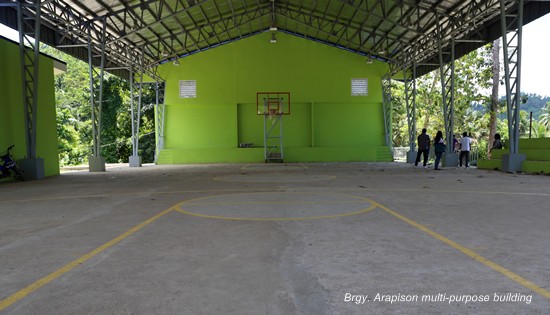
By
GISSELLE G. PARUNGAO
November 15, 2020
CALBAYOG CITY –
Four (4) multi-purpose buildings (MPBs) were built in Calbayog City,
Sta. Margarita and Gandara with a total allocation of P33 million,
said Samar First District Engineering Office.
One of these MPBs was from
Barangay Dumaloong in Gandara which will serve as a day-care center
that will be used by children in the barangay and allotted with P3
million. Two (2) other MPBs were also built in Calbayog City. One
was built in Barangay Danao 1 that was made as a covered court while
the MPB in Barangay Guin-on was designed as a basketball court. They
were both allotted P5 million each.
The three (3) MPBs were
drawn from the General Appropriations Act (GAA) of 2020.
Another completed MPB in
Barangay Arapison is allotted with P20 million from the General
Appropriations Act (GAA) of 2019. This comes with three (3) comfort
rooms including those for persons with disability (PWDs).
DPWH is doing its part in
developing the communities as a whole, by providing MPBs that can
serve as venues for livelihood seminars, medical and dental
missions, feeding programs, recreational events, sports
competitions, and other activities. The buildings are also designed
to provide temporary shelter for local residents in the event of
flooding during typhoons and other calamities.
Two road projects
completed by Samar 1

By
VENUS VILLANUEVA
November 14, 2020
CALBAYOG CITY – The
Department of Public Works and Highways Samar First District
Engineering Office has completed the construction and rehabilitation
of two barangay roads in the first district of Samar.
One of the completed
projects is the rehabilitation of población roads in Pagsanghan,
Samar. The P19.4-million project is a five-meter wide concrete road
covering a span of 1.112 kilometers.
To further support the
improvement of the said roads, the project covers 327 meters of open
line canal for drainage. This is an essential structure to avoid
flooding in the town proper where most of the residential areas in
the barangay are located. Slope protection structure of 96 meters in
length, are also installed to prevent erosion since some parts of
the población roads are located alongside of Gandara River which
passes through the west part of the barangay.
On the other hand, a
concrete road in Brgy. Cabungaan, Tarangnan, Samar is constructed
with 0.758 lane-kilometers length (2.5 meters wide) of concrete
roads, amounting to P4.5-million.
This project supplements
the existing provincial roads connecting Brgy. Cabungaan to the town
proper of the Municipality of Tarangnan, Samar, providing for a more
convenient transport of goods and people in the barangay.
Both projects, which are
funded through the district’s Local Infrastructure Program aims to
help improve the quality of transportation by providing a safe,
efficient, and reliable infrastructure thus contributing to the
economic growth of the community.
|
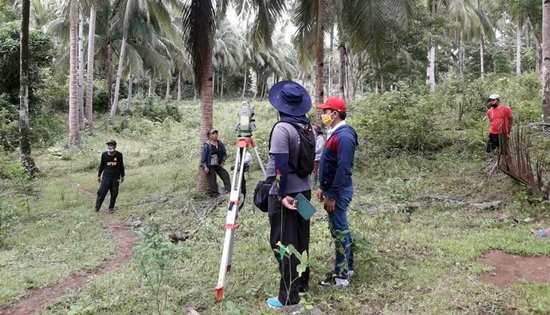
The
survey team of the Department of Agrarian Reform (DAR)
Samar Provincial Office conducts subdivision survey on
an 8.4-hectare landholding covered by a collective
Certificate of Land Ownership Award (CLOA) in Motiong,
Samar. (Photo by Reynaldo Labine) |
DAR subdivides
lot in Samar town despite rise of COVID-19 cases
By
JOSE ALSMITH L. SORIA
November 13, 2020
MOTIONG, Samar –
Despite the continuous rise of coronavirus disease 2019 (COVID-19)
cases in the province of Samar, the survey teams of the Department
of Agrarian Reform (DAR) remain unstoppable in performing their
tasks.
Last week, Engr. Enan Chua
and Ferwell Aquino of the DAR Samar Provincial Office survey team
proceeded to this town to subdivide an 8.4-hectare landholding
covered by a collective Certificate of Land Ownership Award (CLOA)
for the eventual issuance of individual titles.
According to OIC-Municipal
Agrarian Reform Program Officer (MARPO) Constancio Mabag, the said
collective CLOA was issued in 1996 to four agrarian reform
beneficiaries (ARBs) under the government’s Comprehensive Agrarian
Reform Program (CARP).
Mabag disclosed that the
area is situated in the upland barangay of Candumacol, some nine
kilometers away from the town proper.
Meanwhile, the province of
Samar, as of press time, posts the highest number of coronavirus
disease 2019 (COVID-19) cases in Eastern Visayas with 2,383.
However, based on the
Department of Health (DOH) data, 2,240 of them have already
recovered, leaving a total of 143 active cases and 21 deaths.
(with reports from Reynaldo Labine)
Eastern Visayas
inflation rate declines to 1.8% in September
By
PSA-8
November 6, 2020
TACLOBAN CITY –
Inflation Rate (IR) in Eastern Visayas declined to 1.8 percent in
September 2020. This figure is 0.5 percentage point lower than the
2.3 percent IR recorded in August 2020. The September 2020 IR of the
region, however, is higher by 1.9 percentage points compared with
the 0.1 percent deflation in the same period last year.
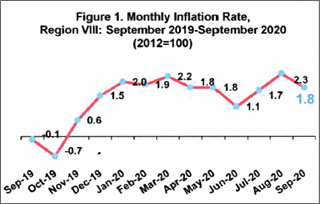 The regional IR is 0.5
percentage point lower than the 2.3 percent national average in
September 2020.
The regional IR is 0.5
percentage point lower than the 2.3 percent national average in
September 2020.
Among provinces, Samar
posted the highest IR in September 2020 at 5.3 percent. This figure
is 1.0 percentage point higher compared with its 4.3 percent IR in
August 2020. Southern Leyte and Eastern Samar also recorded
increases by 0.1 percentage point, resulting to an IR of 3.1 percent
and 1.6 percent, respectively.
Leyte retained its
previous month’s IR of 1.3 percent.
Alcoholic beverages and
tobacco commodity group continued to post the highest IR at 7.6
percent in September 2020, followed by restaurant, miscellaneous
goods and services at 4.7 percent.
Of the 11 commodity groups
in the region, four (4) commodity groups exhibited lower IRs in
September 2020 compared with their figures in 2020. The commodity
group for housing, water, electricity, gas and other fuels declined
by 2.2 percentage points from 1.5 percent IR in August 2020 to 0.7
percent deflation in September 2020. This can be traced to the
continued decline in the index for electricity, gas and other fuels
from 0.7 deflation in August 2020 to 6.8 percent deflation in
September 2020.
The IR for furnishing,
household equipment and routine maintenance declined by 0.5
percentage point from 3.2 percent in August 2020 to 2.7 percent in
September 2020.
Compared with their
figures in August 2020, the IRs for both clothing and footwear
commodity group and health commodity group decreased by 0.2
percentage point settling down to 3.1 percent and 1.0 percent,
respectively, in September 2020.
On the other hand, four
(4) other commodity groups exhibited higher IRs in September 2020
compared with their rates in August 2020. Transport commodity group
posted the highest increase of 2.2. percentage points, from 0.5
percent in August 2020 to 2.7 percent in September 2020. This can be
attributed to the 4.7 percentage points increase in the index for
transport services, from 1.4 percent in August 2020 to 6.1 percent
in September 2020.
The IR for education
commodity group went up to 0.4 percent in September 2020 from zero
IR in the previous month. This increase is due to the 1.4 percent
increase in the index for pre-primary and primary education.
The IR for restaurant and
miscellaneous goods and services commodity group rose to 4.7 percent
in September 2020, higher by 0.3 percentage point compared with the
4.4 percent IR a month ago. This can be attributed to the 0.3
percentage point increase for both indices of catering services and
personal care.
The index for recreation
and culture commodity group inched up by 0.1 percentage point, from
2.0 percent deflation in August 2020 to 1.9 percent deflation in
September 2020.
Alcoholic beverages and
tobacco, and food and non-alcoholic beverages commodity groups
retained their previous month’s IRs at 7.6 percent and 2.2 percent
respectively. Meanwhile, communication commodity group retained its
previous month’s deflation at 1.7 percent.
The Purchasing Power of
Peso (PPP) of the region remained at P0.79 in September 2020. This
PPP implies that the goods and services worth P79.00 in 2012 is
worth P100.00 in September 2020.
PPP in Northern Samar
strengthened by P0.01 compared with its figure in August 2020.
Biliran weakened by P0.01, while the rest of the provinces retained
their previous month’s PPP.
Biliran recorded the
strongest PPP at P0.82. Leyte ranked second at P0.81, followed by
Southern Leyte at P0.80, Eastern Samar at P0.77 and Northern Samar
at P0.74. Samar posted the weakest PPP at P0.73.

Pre-school show
“Tish Tash” all set for worldwide distribution

By
DTI-Foreign Trade
Service Corps
November 3, 2020
MAKATI CITY –
Animated pre-school show “Tish Tash” will soon be enjoyed by kids
around the world after leading kids entertainment specialist CAKE
has inked a distribution deal with its producers – Korea’s Studio
Gale, Singapore’s August Media Holdings, U.K.’s Karrot
Entertainment, and Philippines’ Synergy Entertainment Media.
“Tish Tash has huge potential – a fresh take on what it’s like to
have an imaginary friend, something most children have experienced
and can relate to,” said CAKE CCO & Managing Director Ed Galton.
“We are very excited to be working with strong partners from around
the world, whose collaboration has resulted in a truly global
approach,” he added.
Synergy88 COO and Managing Director Jackeline Chua also expressed
her excitement over this landmark deal.
“We’re excited to see another show come to life and now distributed
globally. It was a great collaboration with Studio Gale and August
Media. Tish Tash is just one of the many shows that Synergy88 has
co-produced with the best global entertainment companies,” she said.
Chua also recounted how Synergy88’s participation in the government
sponsored outbound business missions in Cannes from 2016-2018 had
opened opportunities for global partnerships.
“The company’s portfolio of properties now spans across television,
mobile and web platforms targeting pre-school kids all the way to
millennials. We’re truly glad that DTI-Export Marketing Bureau &
FTSC (DTI Foreign Trade Service Corps) have been very active and
supportive in promoting PH’s global presence in the creative
industry.”
DTI Secretary Ramon Lopez welcomed this development, saying, "We
have been pushing for the promotion of the economic potential of our
creative industries globally and we are happy to see developments
like this. The creative industry is a high value-adding sector, and
the country has a natural competitive edge in this area, considering
its rich pool of talents."
DT-FTSC Executive Director Anthony Rivera also added, "We will
continue to collaborate with the creative industry stakeholders and
government partners to help promote and develop opportunities in the
creative sector such as in advertising, animation, film, game
development and design among others. We hope to feature more of our
creative capabilities and gain more access in international markets
for Philippine made content."
Aside from “Tish Tash,” Synergy88 also paved the way for the
country’s first Filipino animated series “Barangay 143,” which aired
on free-to-air television channel GMA 7 in 2018. It made headlines
once again last Oct 1 as it premiered on streaming giant Netflix and
made it to the top ten most watched titles for the week.
|
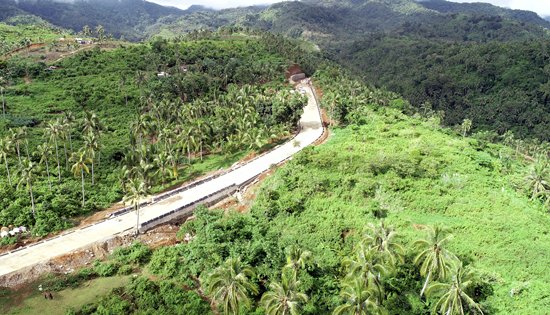
The
aerial view of the on-going construction of access road
leading to Talustusan Falls in Naval, Biliran. The
project involves the concreting of existing gravel road
and a rehabilitation of existing damaged paved road with
a length of 1.215-kilometer two lane road. |
Tourism road
leading to Talustusan falls in Biliran now halfway complete
By
DPWH Biliran
October 29, 2020
NAVAL, Biliran –
The Department of Public Works and Highways- Biliran District
Engineering Office’s (DPWH-BDEO’s) access road project leading to
Talustusan Falls in Naval town is now halfway complete.
David P. Adongay Jr.,
District Engineer said that the project is being fast-tracked for
completion on January 03, 2021, the revised expiry date.
“Not only the tourists
will benefit from this project but also the farmers along this road
project will enjoy a wider, safer, and convenient transport of
agricultural products to market centers,” said Adongay.
The improvement of access
road leading to Talustusan Falls involves the road opening and
concreting and rehabilitation of existing damaged paved road at
Sitio Magtaran-an, Brgy. Talustusan with a length of 1.215-kilometer
two lane road.
This project is
implemented under fiscal year 2020 with a contract amount of P31.3M.
DPWH in convergence with
the Department of Tourism (DOT) has allotted P105M under multi-year
funding to enhance the hidden waterfalls in the province.
The fund will be
implemented by phases from year 2020-2022 with a total length of
4.715-Kilometer two-lane road with a width of 6.10-meter and a
thickness of 0.23-meter.
The completion of this
project by phases will help boost tourism in the province. Walking
time will also be reduced from 30-40 minutes to just 3-5 minutes to
reach the waterfalls.
|
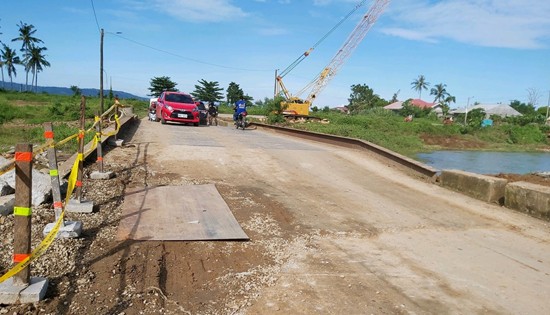
Effective
6:00 AM October 27, Caraycaray Bridge Detour along
Biliran-Naval Section is open to all types of vehicles.
DPWH-Biliran DEO in coordination with LM Baltonado
construction complete the restoration works of the
scoured approaches (Caraycaray Side) after being damaged
by continuous heavy rains brought by Tropical Storm “Quinta”. |
Bridge detours
damaged by TS Quinta in Biliran completes restoration
By
DPWH Biliran
October 28, 2020
NAVAL, Biliran –
The Department of Public Works and Highways (DPWH)- Biliran District
Engineering Office (DEO) has completed the restoration works of the
scoured approaches of the Caraycaray and Catmon Bridge detours.
David P. Adongay Jr.,
District Engineer informed that effective 6:00 AM on October 27,
2020 the Caraycaray and Catmon Bridge detours along Biliran-Naval
section are now open to all types of vehicles (lightweight, four (4)
wheels and heavy equipment).
Restoration works which
involve backfilling were done in coordination with DPWH-BDEO and LM
Baltonado Construction.
According to Adongay,
DPWH-Biliran DEO is exerting their efforts and closely monitoring
and coordinating with the contractor under contract with DPWH
Regional Office VIII to restore the said detours for the safe
passage of the motorists and the travelling public.
“These detours are deemed
important as the construction of both Caraycaray and Catmon Bridges
are on-going at present,” said Adongay.
“Travelling public
especially heavy equipment operators will no longer need to take a
longer route to travel to the capital town of Naval and to its
neighboring municipalities,” the District Engineer added.
The District Engineer also
acknowledges the help extended by Businessman Mr. Robert Juve Yao
Ang to fast-track the repair of the detours.
The Caraycaray and Catmon
detours were damaged due to continuous heavy rains brought by
Tropical Storm “Quinta” on October 25, 2020.
China asked to
listen to the people to make BRI “people-centered”
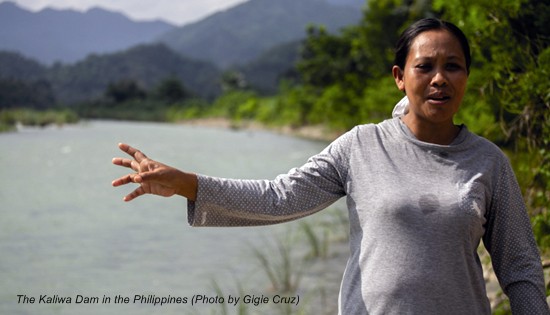
Press Release
October 28, 2020
MANILA – Eight
national and Asian regional organizations based in the Philippines,
Indonesia, Bangladesh, Pakistan, and Sri Lanka on Wednesday asked
China to listen to the voices of the people in communities most
directly affected by Belt and Road Initiative (BRI) projects.
In a virtual press
conference, leaders of the organizations said appropriate
consultations with the local communities transformed by the BRI
projects would maximize social benefits, minimize investment risks,
and make the BRI truly “people-centered.”
A new book chronicling the
effects of the BRI projects in the Philippines, Indonesia,
Bangladesh, Pakistan and Sri Lanka turns the spotlight on the views
of people affected by the BRI projects. The book was launched during
the virtual press conference.
“Numerous books, studies,
and research papers have been produced by governments, companies,
economists, and investors about the BRI. The voices from the most
important community, however, have not been heard,” Lidy Nacpil,
coordinator of the Asian People’s Movement on Debt and Development (APMDD),
said during the launch of “Belt and Road through My Village.”
The “Belt and Road through
My Village,” co-produced by eight non-governmental organizations, is
a collection of interviews with over 100 villagers who live on sites
where BRI projects are being undertaken.
China’s total investments
in countries where BRI projects are ongoing reached USD 117.31
billion, according to the 2019 China Outbound Direct Investment
Statistical Report released recently by China’s Ministry of
Commerce, the National Statistics Bureau, and the State
Administration of Foreign Exchange.
As of end-2019, over
27,500 Chinese investors have established 44,000 direct investment
enterprises in 188 countries and regions where BRI projects are
located.
“The lives of billions of
people in these 188 countries are being affected directly and
indirectly, positively and negatively, and their lives are changed
forever,” Nacpil said.
The book project was led
by the People of Asia for Climate Solutions (PACS) and APMDD, and
supported by Asia Comms Lab, Philippine Movement for Climate Justice
(PMCJ), Indonesia’s Koalisi Rakyat untuk Hak Atas Air (KruHA:
People's Coalition for the Right to Water), Coastal Livelihood and
Environmental Action Network (CLEAN) in Bangladesh, the Pakistan
Kissan Rabita Committee (PKRC), and the Centre for Environmental
Justice (CEJ) in Sri Lanka.
The book covered seven
major BRI projects. They are the Kaliwa Dam in the Philippines, the
Jakarta-Bandung High-Speed Rail in Indonesia, the Barisal 350 MW
Coal Power Plant in Bangladesh, the Bahawalpur Solar Power Park and
Sahiwal Coal-Fired Power Plant in Pakistan, the Colombo Port City
and the Colombo Highways in Sri Lanka. The total population being
affected by these seven projects alone stands at more than 15
million.
Based on the interviews,
renewable energy and road construction are among the most welcomed
projects, while lack of communication and transparency, especially
with communities on the sites of the projects, unfair employment
practices, and social and environmental impacts are among the most
frequently raised complaints.
The following are
snapshots of the stories and quotes in the book:
Philippines: the Kaliwa Dam Project
Water crisis is a serious
challenge for the growing population in Metro Manila.
Mike Santos, a barangay
official from Barangka Drive, Mandaluyong City, said they had to
mobilize fire trucks to distribute water to residents. Santos said
even with the emergency water distribution, “residents were easily
angered despite our efforts because they were getting impatient over
the situation.”
The Kaliwa Dam is part of
the New Centennial Water Source projects to provide new water
sources for Metro Manila and other nearby provinces. The project
involves the construction of a 600 million liter-per-day (mld)
capacity dam (73m high) and a conveyance tunnel that has a capacity
of 2,400 mld (27.70km long, 4m diameter, around 200m deep).
Around 300 indigenous
people will be displaced from their ancestral lands when the
construction begins. Once completed, the project will inundate a
large part of Barangay Daraitan in Rizal and several areas,
including Barangay Pagsangahan and Barangay Magsaysay in Quezon
Province. Residents of indigenous communities living along the
Kaliwa River said they were not fully informed nor consulted about
the project. “We remain clueless about the proposed dam,” Maria
Clara Dullas, 39, a resident of Daraitan, in Rizal province near
Metro Manila, said. “The Metropolitan Waterworks and Sewerage
Systems has not reached out to residents of Daraitan to explain its
possible impacts on the community,” she said.
Indonesia: the Jakarta-Bandung High-Speed Rail
Talking about the Jakarta-Bandung
High-Speed Railway, 23-year-old student Nissa Nurmauluddiana said:
"I think this is positive because there will be many transportation
options to Jakarta, especially now, Bandung people who work in
Jakarta or Jakarta people who are on business to Bandung always run
out of train tickets.”
The project was envisioned
to be completed in 2019, but was delayed due to problems related to
land acquisition and compensation to villagers and local workers.
The total investment is estimated to be USD $5.5 billion. About
124,000 villagers have been affected by the construction of the
railway.
According to KRuHA, which
works closely with the local communities, some people protesting the
land acquisition have been beaten and arrested. They are gravely
concerned about reports of incidents of human rights abuses.
Silvi Febrianti, a college
student from Gempolsari village in Bandung said: “until now, I have
not heard any news from the government about our land compensation
money. It’s not clear enough when we will get it, and how much we
will receive. I want to move as soon as possible.”
Bangladesh: the Barisal 350 MW Coal Power Plant
Maliha Hossain, 38, a
business woman, talked about the importance of electricity to her
online business and to Dhaka. “In Dhaka city, there is an unlimited
number of food courts and recreational activities, if electricity
stops working, everything stops. This is a matter of great
satisfaction. But for the last three years or more, we have been
getting an uninterrupted electricity supply.”
However, she also voiced
her worries about possible air pollution from the coal-fired power
plant project.
The Barisal coal-fired
power plant project is expected to begin operations in 2022. The
entire project will require 300 acres of land and the government is
expected to buy power from this plant for a period of 25 years,
according to the agreement. The project site is surrounded by land
reserved for wildlife and fish sanctuaries. Villagers said they were
forced to evacuate the land to give way for the project.
Abdul Malek Mosulli, 96,
from Taltoli, is one of the hundreds of villagers who lost his
house. “Local villagers protested, but police brought charges
against innocent young men,” he said.
Now the village is visibly
divided into two parts: the high land acquired for the power plant
and low land where the villagers relocated. With the recent floods,
the relocation site has been underwater for months. There is no
drinking water and no fish to catch. The residents are jobless. A
number of people have become laborers at the plant site.
Pakistan: Bahawalpur Solar Power Park and Sahiwal Coal-Fired Power
Plant
“Our lands have gone from
zero to hero since the Quad-i-Azam Solar Power Park project was
initiated in the area,” Muhammad Iqbal, 62, a counselor in Chak
6-BC, one of the villages close to the solar power park in
Bahawalpur, said.
The Quaid-i-Azam Solar is
a 100 MW solar plant spanning 200 hectares of desert land, and
Sahiwal Coal-Fired Power Plant, encompassing 690 hectares of fertile
land, has an installed capacity of 1320 megawatts.
In a different village,
Noman Bhatti, 40, was not happy with the Sahiwal Coal-fired Power
Plant. “I’m still at a loss to understand why the most fertile land
in the Punjab province has been selected to commission such an
anti-agriculture project,” Bhatti said. “We, the affected community,
had approached the court of law to resist installation of the plant
here. Some officials managed to blackmail most of the plaintiffs in
the name of National Interest.”
Sri Lanka: The Colombo Port City and Colombo Highways
In 2019, China and Sri
Lanka signed an agreement to further fund and build the Central
Expressway Project (CEP).
Tharushika Wickramasinghe,
25, talked about how she had changed her mind about highways near
her house after experiencing the new conveniences: “I would like to
see more highways coming up in the country and want the Chinese to
help the Sri Lankan government to build more expressways.”
The Colombo Port City was
proposed in early 2012 by the China Harbour Engineering Corporation
as the site for constructing the Colombo International Financial
City. The project is expected to be completed by 2041 and will be on
a 99-year lease.
Aruna Roshantha Fernando,
a 49-year old fisherman, raised questions about it: “I don’t think
Sri Lanka needs such a big city port in Colombo. Only the rich
people will benefit from this project. What happens to poor people
like us who earn a living by the resources of the sea?”
“People-to-people
connectivity is supposed to be the ultimate vision for BRI,
alongside policy connectivity, infrastructure connectivity, trade
connectivity, and financial connectivity,” Xiaojun Wang, executive
director of PACS, said.
All the testimonials are
presented in the book in the native languages of the villagers, and
have been translated into English and Chinese for international and
Chinese audiences.
At the 75th Session of the
United Nations General Assembly in September 2020, President Xi
Jinping called on all major countries to act with leadership. “They
should provide more global public goods, take up their due
responsibilities and live up to people's expectations.” This was a
continuation of his call for China and host countries “to act on the
principles of high standard, people-centered and sustainable
development” at the 2nd Belt and Road Forum in Beijing in April
2019.
“In order to achieve true
‘people-centered’ vision for the BRI, China must work with host
country governments and be more proactive in reaching out to the
communities to be affected,” Wang concluded. “Only when these voices
are heard, will social, environmental, political and financial risks
be minimized, and will real benefits and welfare improvements be
shared by all involved.”